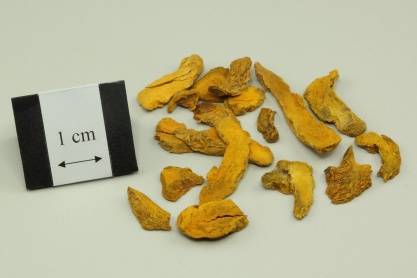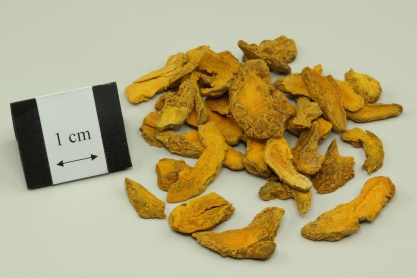薑黃
- ENG
- Turmeric
- LATIN
- Curcumae Longae Rhizoma
| Medicinal Group | Blood-activating analgesic medicinal |
|---|---|
| Source | Dried rhizome of Curcuma longa L. (Fam. Zingiberaceae) |
| Nature and Flavors | pungent, bitter; warm |
| Meridian Affinity | Liver, Spleen |
| Actions | To elimainate blood stasis, promote the flow of qi, stimulate mentrual discharge and relieve pain |
Family
Zingiberaceae
Part used
Root and Rhizome
Indications
Pricking pain in the chest and hypochondriac regions; amenorrhea; mass formation in the abdomen; rheumatic pain of the shoulders and arms; traumatic swelling and pain
Research Findings
- Regular ingestion of turmeric reduces plasma malondialdehyde and increases red blood cell catalase activity and plasma albumin levels in hemodialysis patients. [1]
- Gargling with turmeric by head and neck cancer patients undergoing radiation therapy provided significant benefit by delaying and reducing the severity of mucositis.[2]
- Co-ingestion of turmeric with white bread increases working memory independent of body fatness, glycaemia, insulin, or Alzheimer's disease biomarkers.[3]
- The possible efficacy of turmeric in decreasing high-sensitivity C-reactive protein and uremic pruritus in end stage renal disease patients is shown. [4]
- Curcuma longa may have an effect on insulin secretion.[5]
- Short-term turmeric supplementation can attenuate proteinuria, TGF-β and IL-8 in patients with overt type 2 diabetic nephropathy and can be administered as a safe adjuvant therapy for these patients.[6]
- Turmeric is definitely a good adjunct to mechanical plaque control.[7]
Cautions
No Data.
Report on adverse effect
Allergic dermatitis [8]
Reference
Reference
- Pakfetrat M, Akmali M, Malekmakan L, Dabaghimanesh M, Khorsand M. (2015). Role of turmeric in oxidative modulation in end-stage renal disease patients. Hemodial Int. , 19(1):124-31. doi: 10.1111/hdi.12204. Epub 2014 Aug 16.
- Rao S, Dinkar C, Vaishnav LK, Rao P, Rai MP, Fayad R, Baliga MS. (2014). The Indian Spice Turmeric Delays and Mitigates Radiation-Induced Oral Mucositis in Patients Undergoing Treatment for Head and Neck Cancer: An Investigational Study. Integr Cancer Ther. , 13(3):201-10. doi: 10.1177/1534735413503549. Epub 2013 Oct 28.
- Lee MS, Wahlqvist ML, Chou YC, Fang WH, Lee JT, Kuan JC, Liu HY, Lu TM, Xiu L, Hsu CC, Andrews ZB, Pan WH. (2014). Turmeric improves post-prandial working memory in pre-diabetes independent of insulin. Asia Pac J Clin Nutr. , 23(4):581-91. doi: 10.6133/apjcn.2014.23.4.24.
- Pakfetrat M, Basiri F, Malekmakan L, Roozbeh J. (2014). Effects of turmeric on uremic pruritus in end stage renal disease patients: a double-blind randomized clinical trial. J Nephrol. , 27(2):203-7. doi: 10.1007/s40620-014-0039-2. Epub 2014 Jan 31.
- Wickenberg J, Ingemansson SL, Hlebowicz J. (2010). Effects of Curcuma longa (turmeric) on postprandial plasma glucose and insulin in healthy subjects. Nutr J. , 9:43. doi: 10.1186/1475-2891-9-43.
- Khajehdehi P, Pakfetrat M, Javidnia K, Azad F, Malekmakan L, Nasab MH, Dehghanzadeh G. (2011). Oral supplementation of turmeric attenuates proteinuria, transforming growth factor-β and interleukin-8 levels in patients with overt type 2 diabetic nephropathy: a randomized, double-blind and placebo-controlled study. Scand J Urol Nephrol. , 45(5):365-70. doi: 10.3109/00365599.2011.585622. Epub 2011 May 31.
- Waghmare PF, Chaudhari AU, Karhadkar VM, Jamkhande AS. (2011). Comparative evaluation of turmeric and chlorhexidine gluconate mouthwash in prevention of plaque formation and gingivitis: a clinical and microbiological study. J Contemp Dent Pract. , 12(4):221-4.
- Seetharam KA, Pasricha JS. Condiments and contact dermatitis of the finger-tips. Indian journal of dermatology, venereology and leprology, 1987, 53:32–328.












